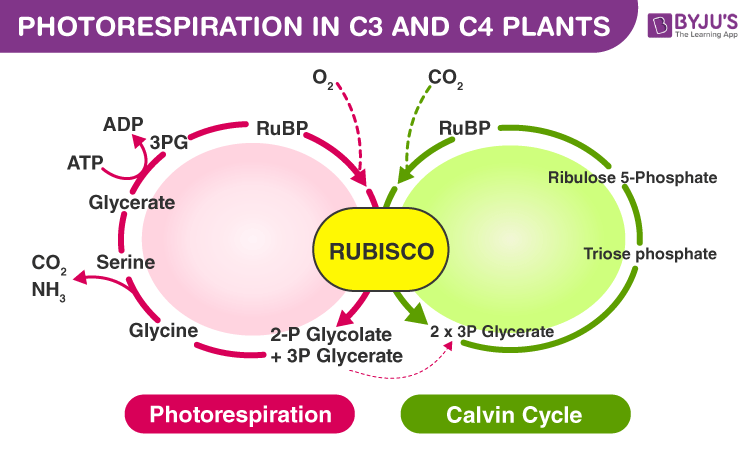Photosynthesis is the biological process by which all green plants, photosynthetic bacteria and other autotrophs convert light energy into chemical energy. In this process, glucose is synthesised from carbon dioxide and water in the presence of sunlight. Furthermore, oxygen gas is released out into the atmosphere as the by-product of photosynthesis.
The balanced chemical equation for the photosynthesis process is as follows:
6CO2 + 6H2O —> C6H12O6 + 6O2
Sunlight is the ultimate source of energy. Plants use this light energy to prepare chemical energy during the process of photosynthesis. The whole process of photosynthesis takes place in two phases- photochemical phase and biosynthetic phase.
In-depth Reading: Photosynthesis
The photochemical phase is the initial stage where ATP and NADPH for the biosynthetic phase are prepared. In the biosynthetic phase, the end product – glucose is produced. Let us focus more on pathways in biosynthetic phase.

During the biosynthetic phase, carbon dioxide and water combine to give carbohydrates i.e. sugar molecules. This reaction of carbon dioxide is termed as carbon fixation. Different plants follow different pathways for carbon fixation.
Based on the first product formed during carbon fixation there are two pathways: the C3 pathway and C4 pathway.
The Pathway of Photosynthesis
C3 Pathway (Calvin Cycle)
The majority of plants produce 3-carbon acid called 3-phosphoglyceric acid (PGA) as a first product during carbon dioxide fixation. Such a pathway is known as the C3 pathway which is also called the Calvin cycle.
Calvin Cycle occurs in three steps:
- carboxylation
- reduction
- regeneration
In the first step, the two molecules of 3-phosphoglyceric acid (PGA) are produced with the help of the enzyme called RuBP carboxylase. Later in the second and third steps, the ATP and NADPH phosphorylate the 3-PGA and ultimately produces glucose. Then the cycle restarts again by regeneration of RuBP.
Beans, Rice, Wheat, and Potatoes are an example of plants that follow the C3 pathway
C4 Pathway (Hatch and Slack Pathway)
Every photosynthetic plant follows Calvin cycle, but in some plants, there is a primary stage to the Calvin Cycle known as C4 pathway. Plants in tropical desert regions commonly follow the C4 pathway. Here, a 4-carbon compound called oxaloacetic acid (OAA) is the first product by carbon fixation. Such plants are special and have certain adaptations as well.
The C4 pathway initiates with a molecule called phosphoenolpyruvate (PEP) which is a 3-carbon molecule. This is the primary CO2 acceptor and the carboxylation takes place with the help of an enzyme called PEP carboxylase. They yield a 4-C molecule called oxaloacetic acid (OAA).
Eventually, it is converted into another 4-carbon compound known as malic acid. Later, they are transferred from mesophyll cells to bundle sheath cells. Here, OAA is broken down to yield carbon dioxide and a 3-C molecule.
The CO2 thus formed, is utilized in the Calvin cycle, whereas 3-C molecule is transferred back to mesophyll cells for regeneration of PEP.
Corn, sugarcane and some shrubs are examples of plants that follow the C4 pathway. Calvin pathway is a common pathway in both C3 plants and C4 plants, but it takes place only in the mesophyll cells of the C3 Plants but not in the C4 Plants.
To know more about C3 and C4 pathways in plants, visit BYJU’S.

Further Reading:


If we apply the C4 pathway to the C3 plants, which characteristics do you think the plant will follow the C3 or the C4 characteristics?
I think it will follow C3 characteristics because C3 plants do not have bundle sheath cells to follow C4 pathway.
I am impressed by the approaches given
Tq for the information